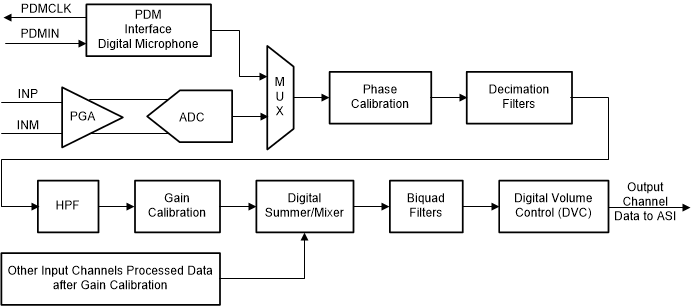SBAA378B November 2019 – December 2023 PCM3140-Q1 , PCM5140-Q1 , PCM6140-Q1 , TLV320ADC3140 , TLV320ADC5140 , TLV320ADC6140
- 1
- Abstract
- Trademarks
- 1 Introduction
- 2 Infinite Impulse Response Filters
-
3
TLV320ADCx140/PCMx140-Q1 Digital Biquad Filters
- 3.1 Filter Design Using PurePath™ Console
- 3.2 How to Generate N0, N1, N2, D1, and D2 Coefficients with a Digital Filter Design Package
- 3.3 Avoid Overflow Conditions
- 3.4 Digital Biquad FiIter Allocation to Output Channel
- 3.5 Programmable Coefficient Registers for Digital Biquad Filters 1–6
- 3.6 Programmable Coefficient Registers for Digital Biquad Filters 7–12
- 4 How to Program the Digital Biquad Filters on TLV320ADCx140/PCMx140-Q1
- 5 Typical Audio Applications for Biquad Filtering
- 6 Crossover Networks
- 7 Voice Boost
- 8 Bass Boost
- 9 Removing 50 Hz–60 Hz Hum With Notch Filters
- 10Revision History
- 11Digital Filter Design Techniques
1 Introduction
Each channel of the TLV320ADCx140/PCMx140-Q1 device follows the signal chain shown in Figure 1-1. In this signal chain, each channel supports an analog differential or single-ended signal or a digital pulse density modulation (PDM) digital microphone. In TLV320ADCx140/PCMx140-Q1 device families, the analog input signal is amplified by a Programmable Gain Amplifier (PGA) and then converted by a high-performance ADC into a digital signal. The PGA gains the input signal to match the full scale of the ADC. The digital signal has a programmable phase calibration to adjust the phase delay of each channel in steps of one modulator clock cycle. This allows the system to match the phase across different channels. The phase-calibrated digital signal is then decimated through a set of linear phase filters or low-latency filters. DC offset is removed from the decimated signal through a Digital High-Pass Filter (HPF) with three pre-set cutoff frequencies or a fully programmable cutoff frequency. Note that DC shifts are caused by mismatches in common-mode voltages. The output of the HPF is gain calibrated with 0.1-dB steps and summed with other channels. The gain calibration matches the gain across different channels, particularly if the channels have microphones with varying gain values. The output is then filtered by the Digital Biquad Filters and gained by the volume control.
 Figure 1-1 TLV320ADCx140/PCMx140-Q1
Channel Signal Chain Processing Flow Chart
Figure 1-1 TLV320ADCx140/PCMx140-Q1
Channel Signal Chain Processing Flow ChartThis application note concentrates on how to configure the Digital Biquad Filters. The Digital Biquad Filters are digitally implemented as a set of IIR filters.